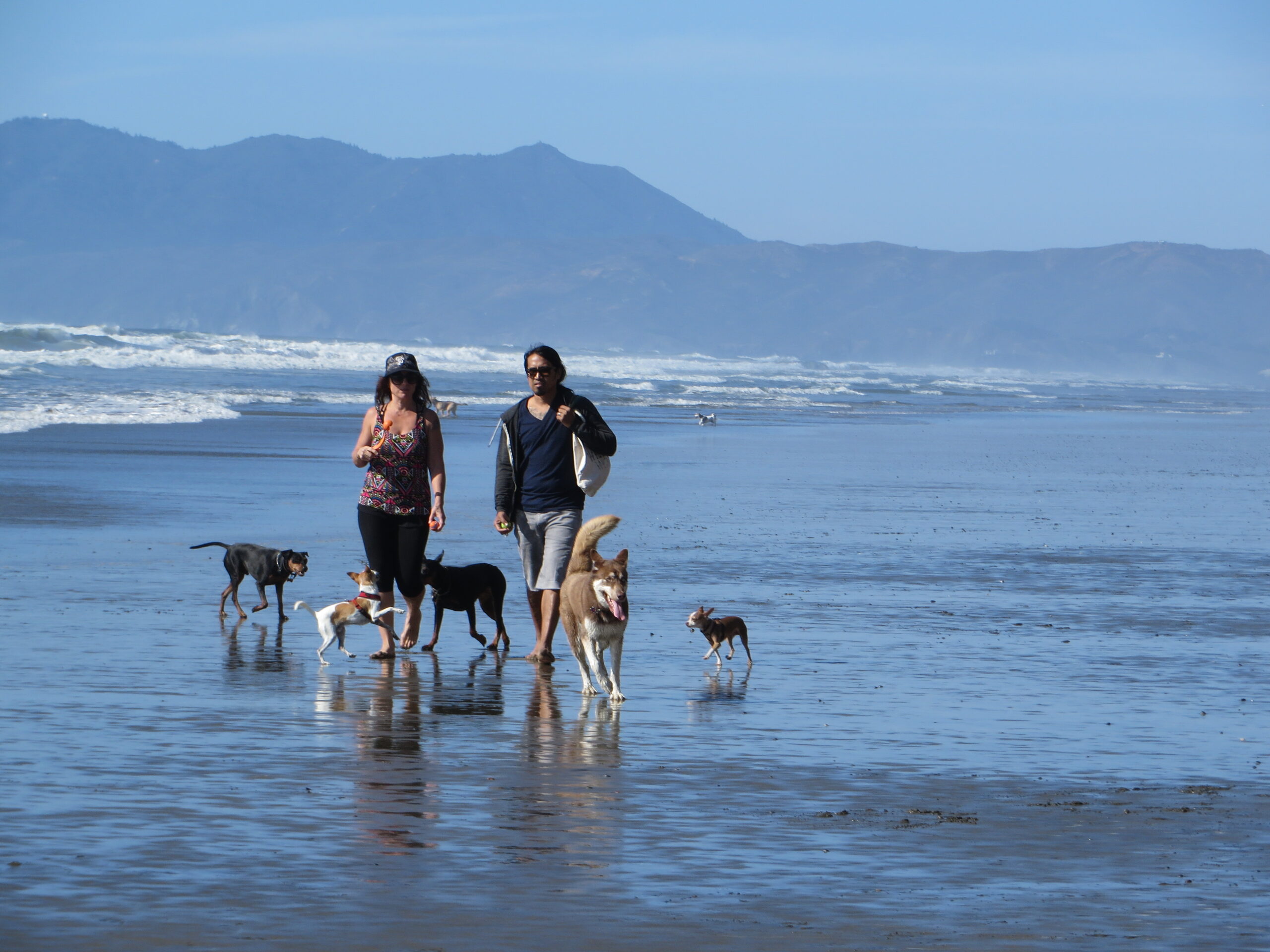dog walker
From Taxis to Dog Walkers: How Convenience Became Affordable for Everyone

The same applies to other industries, such as the dog-walking business. A dream that once could only be in the position of the rich has become a necessity for many employees today. Long hours at the office or physical limitations have made it impossible for some people to care for their pets without outside help. San Francisco, the dog ownership capital of the world, has fully embraced this trend. But it’s not just dog walking—even services like housekeeping are now considered necessary by many lower-middle-class citizens.
A Changing Workforce and Lifestyle
Gone are the days of the traditional 9-to-5 work schedule. Today, people work longer hours just to afford to live in a city like San Francisco. Due to the high charges, such additional services such as dog walking or house cleaning are imperatively required to achieve a work-life balance.
I never experienced this during my early corporate working years, so I was surprised to see such a shift. This generation of working individuals is more inclined to spend money than invest it in a goal such as saving for a house or setting up a savings account. They spend their larger salaries on services that give them more free time.
The Rise of Dog Walkers
Dog walkers have become indispensable to urban life, especially in San Francisco. But, picking a dog walker isn’t just about grabbing anyone off the street— it really depends on what you can afford and what the service needs.
Some experienced dog walkers have a few small but noticeable differences compared to those who are just starting out. For example, seasoned walkers have a better grasp of dogs and their behavior, know how to steer clear of dangers, and handle things in a more professional way. But, you know, these differences do cost something.
The Cost vs. Quality Debate
Much like the Taxi vs. Uber debate, your price for a dog walker can vary significantly. You might be tempted to hire someone who charges less or operates without a business license, but this comes with risks. Many unlicensed dog walkers or companies operate outside the rules and rely on independent contractors instead of employees.
Risks of Cutting Corners
- Dog-walking companies that evade regulations often do not:
- Conduct background checks on their contractors.
- Ensure their contractors are certified dog walkers.
- Obtain necessary park permits.
- Follow strict ethical business practices.
Such an absence of supervision can result in problems. For instance, some walkers may indicate that they will give your dog a one-hour walk but only spend a mere 20 minutes in the park. Sometimes, they can just take a quick pee break instead of going for the normal early morning walk on a rainy day. Even worse, dogs can be put in unsafe situations—like overcrowded cars or poorly supervised park visits.
Questions to Ask Your Dog Walker
To ensure your dog is in good hands, make sure you ask the right questions. Here are some key points to consider:
- Certification and Training: Are they a certified dog walker? What kind of training have they received?
- Background Checks: Does the company conduct thorough background checks on its employees or contractors?
- Park Permits: Do they have the necessary permits to walk dogs in public parks?
- Vehicle Maintenance: How often do they clean and maintain their vehicles?
- Walk Duration: How do they ensure that the promised walk duration is met?
Spotting Red Flags
Beware of dog walkers who:
- Use aggressive or evasive tactics when answering your questions.
- Operate without proper documentation or certification.
- Fail to provide references from other clients.
- Overcrowd their vehicles with too many dogs.
- Take on clients whose dog appears aggressive and mean or jumps on children when not supervised.
Why Experience Matters
Experienced dog walkers, with exceptions, possess certain professionalism that beginners may not possess. For example, they know how to manage dog reactions, either being overly excited or having anxiety issues when getting to the park. When you hire them, expect them to put the safety and well-being of your pet before anything else, unlike those who just want to get paid and care less about their client’s pets.
However, it is regrettable that unethical practices may not be easily detected. Although they may seem charming and professional-looking, they compromise the quality of work.
The Bigger Picture
The rise of affordable services like Uber and dog walking reflects a broader societal shift. Satisfaction has slowly been replaced with convenience to many, meaning this generation has postponed pertinent conventional milestones such as home owning. This interesting evolution shows how cities such as San Francisco fit in today’s world.
However, as consumers, we must be careful when making those choices. While it may seem like you would be better-off to pick cheaper products, it is not without it’s challenges. Ethics, should not be overlooked when selecting a ride-sharing service or a dog walker.
Conclusion
This also means that many people can now easily find generally available services such as Uber and dog walking while making good choices. When it comes to your pet, deciding on the best dog walker means more than choosing a convenient person; you must care about your dog’s safety, happiness, and health. Hiring a trustworthy dog walker requires prioritizing professionalism, ethics, and expertise above saving a few bucks.
A qualified dog walker will give your pet the care and attention they deserve and give you peace of mind as a pet owner. If you’re in San Francisco, the city that sets trends in pet care, it’s time to invest in a reliable and professional dog walker.
Choose a service that fits your values and wants the best for your furry friend. Hire the best San Fransisco Dog Walker Today.
San Francisco Dog Walkers deal with Foxtails
Tips from a San Francisco Dog Walker- Costly Foxtails
All Dog Walkers should tell you the faster you get the dog to the vet, the less it will probably cost to get the foxtail removed.
So, as soon as you dog shows symptoms, such as shaking head or holding head to the side, or licking paws flapping ears or sneezing violently, run, don’t walk him to your vet. If the vet does not have to put the dog under to retrieve the foxtail, the cost may be around $150 for removal. However if you wait a day or two before taking the dog to the vet, the foxtail will travel further up the canal and the cost jumps up around $500 – $1,000 because it now has to be surgically removed. If the foxtail causes an infection because you waited too long, the trip to the vet could run you at least $1,000.00 to $2,000.00! Not removing the foxtail is very dangerous and can be life threatening to the dog because the foxtail penetrates the skin and moves through the bloodstream towards the heart or brain.
San Francisco Dog Walkers should always tell their clients to check for foxtails during the spring and summer months following hikes. Foxtails come from the grasses and are in all of the parks in San Francisco. When pulled apart, the are little arrow shaped pointed stickers that it can burrow into your dogs’ paws, ears, nose, eyes and fur coat.
ON A DAILY BASIS, during foxtail season (when grasses are dry) it is VERY important to check between your dogs’ toes (look up into the cavity of each toe and feel around in there); and to thoroughly feel around in the dog’s fur for foxtails. I try my best to remove the foxtails I find on the dogs after the walk, but it is always good for the owner to also check, as foxtails can and often are, missed.
If your dog begins sneezing violently, even if they stop for a day or two, they most likely have a foxtail in their nose. The worst places to get foxtails are in the ears, eyes and noses because it is very difficult to find and remove them, once they enter these areas on your dog.
San Francisco Dog Walkers share how to keep your dog from getting foxtails:
■ Keep your pet’s fur coat super short during Spring, Summer and Fall months in San Francisco, especially between the toes and around the ears.
■ Long-haired dogs are most prone to having foxtails attach to their fur and embed in the skin. Keep those feet and legs short!
■ Avoid walking your dog in areas where dry grass is prevalent. Take your dog to concrete paths or parks that do not have foxtails. (easier said than done, lol)
■ Prime areas for foxtails to penetrate the skin of an animal are between the toes, in and around the ears, nose, armpits and genitalia. Animals with foxtails under the skin are often licking the affected area where a red bump may be seen. Don’t ignore your dog if they are licking a spot!
■ When returning home from a walk or hike in an area that has foxtails, examine your dog thoroughly and remove any foxtails you might find before they have a chance to burrow into the skin. Also look for and remove burrs at the same time, for your dog’s comfort.
4 Reasons Why You Should Take Your Dog to Dog Training Classes
Many pet owners add a furry friend to their family to enjoy an adorable puppy for cuddles, playtime, and companionship. They may take their pet to all necessary veterinary appointments and hire professional dog walking services to help with exercise. However, they may need to remember an important part of care giving: signing their dog up for dog training classes.
As a professional dog walker in San Francisco, I see dogs of all ages and personalities daily. I can tell you that trained dogs, compared to untrained ones, have better walks, safer interactions, and more fun overall. If you’ve ever wondered, “Is dog training worth it?” these four reasons might convince you to enroll your furry friend in a class today.
-
-
1. Correct Unwanted Behaviors Before They Get Worse
- Without proper guidance, dogs can develop problematic behaviors that worsen over time. For example, your dog might growl or show possessiveness over toys, food, or even people. Other common issues include excessive barking, destructive chewing, and jumping on guests. These behaviors don’t just make life difficult for you—they can be stressful for your dog as well.
-
-
- Dog training helps address these problems in a structured environment. For example, trainers teach owners how to redirect negative behaviors and reward positive ones. Suppose you’re like many San Francisco dog owners; balancing work and pet care can be challenging. Attending training classes can make your life easier by teaching your dog how to behave in everyday situations. From my perspective as a dog walker, a well-behaved dog is more enjoyable and safer to handle.
-
-
2. Improve Control and Safety for Your Dog
- Pet safety largely depends on controlling your dog’s actions indoors and outdoors. Whether I’m walking your dog through a busy San Francisco street or letting them play in an off-leash park, it’s essential to have them respond to commands like sit, stay, come, and heel.
-
-
- Dog training classes lay the foundation for this control. Once your dog masters the basics, you, your dog walker, and anyone interacting with your pup will have a much easier time navigating potentially hazardous situations. For instance, a solid “stay” command could save their life if your dog tries to bolt into traffic. These commands are particularly important in crowded environments like San Francisco’s parks, where distractions are everywhere.
-
- If you’ve been asking yourself, “Is dog training worth it?” consider the peace of mind that comes from knowing your dog is safe, no matter the situation.
-
-
3. Socialization Helps in Many Different Environments
- Dog training also includes socialization. If you have a well socialized dog, then every outing is more fun since your dog is more relaxed with other animals as well as many other people. Training classes are great because you get to take your dog somewhere new, and they learn that crowds, loud noises, and strange environments are no big deal to them.
-
-
- For a dog walker, socialization is important for your dog from a mental perspective. Unsocialized dogs then act nervous or aggressive when they see strangers in public. Instead of a time to spend quality time while exercising, this can make walks a stressful encounter.
-
-
4. Good Leash Etiquette Makes Walks Safer and More Fun
- It’s an opportunity for fun, exercise, and bonding whenever you snap on your dog’s leash and head out for a stroll around the block or an adventure at a local park. The same applies when hiring an expert dog-walking service like mine. The last thing you want is for a walk to feel stressful, frustrating, or unsafe.
-
-
- Dog trainers train many puppy skills best in dog training classes — leash manners are important as a priority. When paired with the “heel” command, these lessons help your pooch hone its impulse control and lack of pulling, lunging, or darting erratically on walks. Not only does that help to make walks more fun, but it can also help to keep you and your pup safe.
-
- Good leash manners are especially important in busy areas like San Francisco, where sidewalks and parks can be crowded. As someone who spends hours walking dogs daily, I can confirm that trained dogs are less likely to injure themselves or their handlers during walks. Better leash manners should be at or near the top of your list of reasons to train your dog if you have ever wondered what the advantages of dog training are.
Why it is Important to get Pet Insurance for Dog!
As a San Francisco dog walker, I’ve seen countless dogs live their best lives, exploring parks, making friends, and thriving in the city’s vibrant environment. But I also witnessed the dark side—the surprise disasters and medical emergencies that leave dog lovers searching for the cure. And that is why I think getting insurance for your dog is one of the best things you can do for your dog. It is not only about money but about your pet having the best care possible, no matter the situation.
They’re Not “Just a Dog”—They’re Family
You may kid yourself into thinking that they are “just a dog,” but the truth is you love them like family. So, when something happens to them, you want to do the right thing and rush them to the vet’s office. Then comes the realization that the cost could be thousands of dollars, and you stubbornly tell yourself again that they are “just a dog.” But when the time comes, your heart will be broken and never repair. The guilt over losing your best friend because you couldn’t afford a procedure will stay with you for a lifetime.
As someone who spends a significant amount of time caring for dogs, I’ve seen this heartbreak in others, and it’s a situation no pet parent should have to endure. That is why dog pet assurance is so important. It allows you to focus on your dog’s health without worrying about expenses.
The Rising Costs of Veterinary Care
High-quality veterinary care does not come at a low cost. Purchasing the best treatment is unlikely without insurance — pet parents make do with less because they cannot afford the cost of a better treatment that would serve their pets well. With pet insurance for a dog, paying the bill money is never a problem for you. Not only do you get the best care possible, but the big payoff is the peace of mind knowing that you have done everything possible for your BFF.
San Francisco is known for its world-class veterinary clinics, but those services come at a price. The costs can add up quickly, whether it’s a routine checkup or a critical surgery. For city-dwelling pet owners, insurance acts as a safety net, ensuring you can always say “yes” to your dog’s care.
Comprehensive Coverage Makes a Difference
One of the pet insurance companies that I often talk about with my clients is called PETPLAN. Although I am not personally experienced with their service, this insurance covers many things other insurance companies need to do.
For example, they cover costs for:
-
-
- Veterinary exams visits for injury or illness
- Cancer treatments like chemotherapy
- Surgery & physical rehab
- Hereditary diseases like hip dysplasia
- Periodontal disease & dental injuries
- Chronic conditions like ear infections
- Prescription medication
-
They also will cover up to 90% reimbursement and have unlimited annual coverage.
It has revolutionized coverage for pet owners. I have watched clients with the means to pay for their dog’s chemotherapy or a seemingly never-ending chronic condition say, “Well thank goodness we don’t have to even think twice about treatment since we are insured.” Not to mention, the smaller but more common expenses, like routine dental cleanings or an ear infection, can quickly add up during the year without insurance, too.
Choosing the Right Pet Insurance
The best advice is to compare pet insurance companies and pick the one with the most coverage. Dog pet insurance plans vary widely, and finding one that fits your needs and budget is essential. Consumers Advocate recently did objective research to create a guide—assisting pet owners in the essential points one should consider when making decisions on pet insurance. I figured you might be interested in reading it. I’ve added a link to the full guide below:
Consumers Advocate Guide to Pet Insurance
The guide gives detailed information about several providers to help you select a policy that suits your pup’s requirements. Whether it is for hereditary diseases, routine care, or emergencies, there is a plan for everyone.
Don’t Wait Until It’s Too Late
The mistake that I see pet owners make most frequently is waiting too late to get insurance. Emergencies don’t come with a warning, and if your dog develops a pre-existing condition before you purchase a policy, that condition likely won’t be covered.
For instance, a simple limp could be a sign of hip dysplasia or a torn ligament—expensive issues to diagnose and treat. Without pet insurance for a dog, you may face tough choices about your dog’s care. With it, you can proceed confidently, knowing you’re doing everything possible for your furry companion.
Why I Recommend Pet Insurance for Dogs
As a San Francisco dog walker, I’ve cared for dogs from all walks of life, and one thing remains consistent: unexpected health issues happen. From playing at the park to mystery illnesses, the peace of mind with dog insurance is worth its weight in gold! I have seen too many owners get paralyzed with a tough decision to make simply because they never foresaw this moment.
Whatever you do, do not procrastinate too long, or you might live to regret it. Pet insurance is an investment in your dog’s health, happiness, contentment, and peace of mind. To your dog, you are more than their human companion; you are family, and they deserve the best care.









